Have you ever stumbled upon an old blog post that’s still driving traffic to your site but no longer hits the mark? Maybe the information is outdated, or the formatting is a bit clunky. Well, it’s time to dust off those old gems and give them a new lease on life! Updating your old blog posts is a powerful strategy for boosting your SEO and engaging your readers. In this comprehensive guide, we’ll walk you through the step-by-step process of revamping your content so you can breathe new life into your blog and watch your traffic soar.
Why It’s Crucial for SEO and Reader Engagement
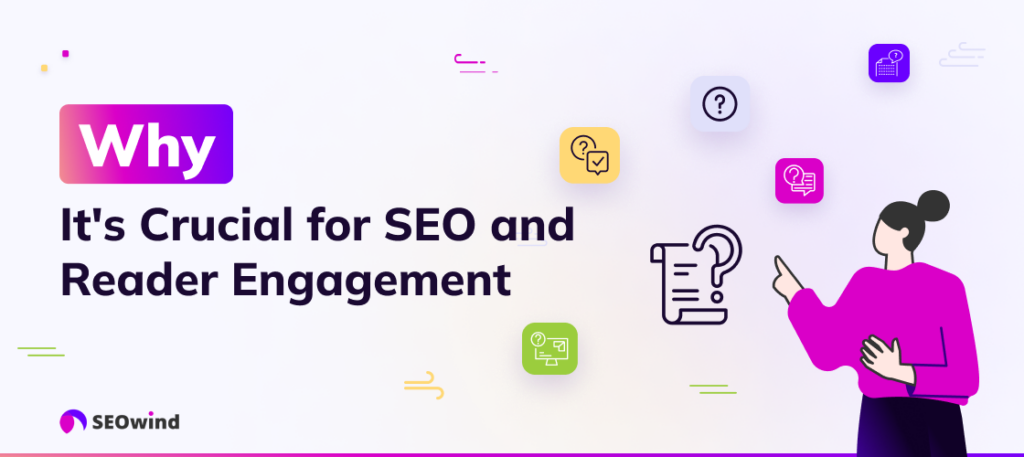
Picture this: you’ve poured your heart and soul into crafting the perfect blog post. It’s informative, engaging, and hits all the right notes. But as time goes by, your masterpiece starts to lose its luster. The information becomes outdated, the formatting looks wonky, and your readers lose interest. That means it’s time to update your old blog post.
By revamping your content, you’re providing fresh, relevant information to your readers and giving your SEO a much-needed boost. In fact, bloggers who update old articles are twice as likely to report “strong results” from content marketing, according to a study by Orbit Media.
When you update your old blog posts, search engines identify that your content is still relevant and valuable. This can lead to improved rankings, increased traffic, and a better user experience for your readers. Plus, by keeping your content fresh and up-to-date, you establish yourself as an authority in your niche and build trust with your audience.
Improving Traffic, Rankings, and Conversion Rates
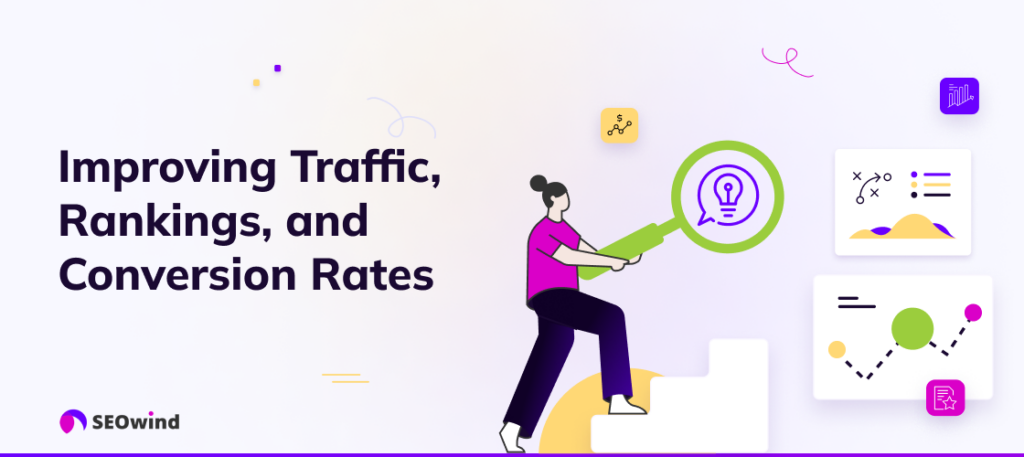
Enhancing Search Engine Visibility
Updating old blog posts can significantly impact your website’s performance. Revamping your content can attract more organic traffic, boost your search engine rankings, and, ultimately, increase your conversion rates.
Increasing User Engagement and Dwell Time
Providing your audience with current, accurate, and engaging content makes it more likely that readers remain on your site longer. This increased dwell time sends positive signals to search engines, improving your rankings. And when visitors find your content informative and helpful, they’re more inclined to trust your brand and take action, whether that means signing up for your newsletter, making a purchase, or contacting you for more information.
The Impact of Fresh Content
According to Tom Zsomborgi, Kinsta has found that you need to add at least 15-20% more fresh and new content to your old post to see a significant increase in traffic. This means that by expanding your existing content and adding new insights, you can attract more visitors to your site and keep them engaged.
In short, updating old blog posts can be a game-changer for your SEO and overall website performance. By improving your content’s relevance, accuracy, and value, you can drive more traffic, secure higher rankings, and boost conversion rates.
Identify Which Blog Posts to Update
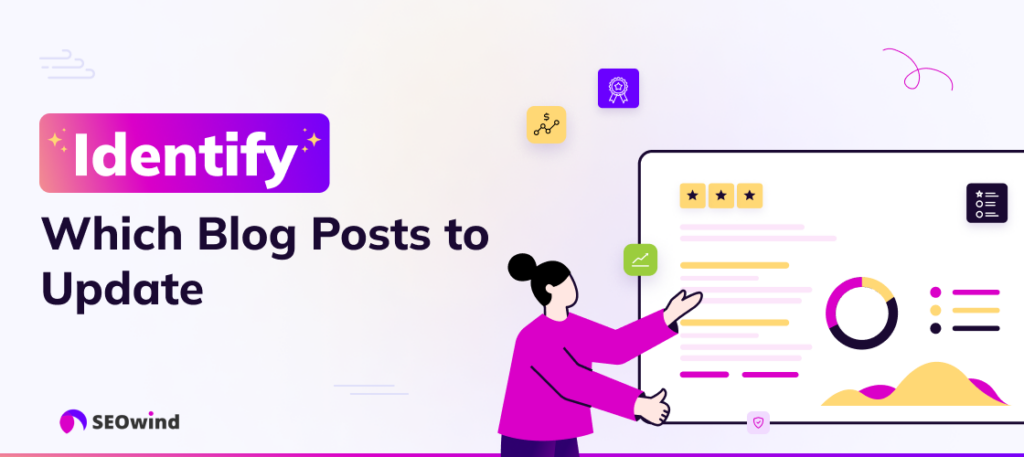
When updating old blog posts for SEO success, the first step is identifying which posts are worth revamping. Not every old post in your archive needs an overhaul. Instead, focus your efforts on those that can most positively impact your traffic, rankings, and overall SEO performance.
Focus on Posts with Declining Traffic or Rankings
One of the primary indicators that a blog post might need an update is a noticeable decline in its traffic or search engine rankings. If you’ve been monitoring your blog’s analytics and noticed posts that once performed well are now experiencing a steady drop in visitors or have slipped in rankings for their target keywords, it’s time to put them on your update list.
These declining posts often contain outdated information, have lost their relevance, or are no longer aligned with the current search intent of your target audience. Revising and refreshing the content allows you to breathe new life into these posts and potentially regain their lost traffic and rankings.
Posts with the Potential to Rank Higher for Target Keywords
Another set of blog posts that should be on your radar are those with untapped potential to rank higher for their target keywords. These posts should already be performing relatively well but possess the ability to climb even higher in search results with some strategic optimizations.
To identify these opportunities, conduct thorough keyword analysis using tools like Google Search Console, SEMrush, or Ahrefs. Look for posts that currently rank on the second or third page of search results for their primary keywords. With the right updates and enhancements, you can boost these posts to the first page and significantly increase their visibility and traffic.
Evaluate Content for Relevance and Accuracy Today
In addition to posts with declining performance or untapped potential, it’s essential to assess your old blog posts for their current relevance and accuracy. Even if a post is still attracting steady traffic, it may contain information that is no longer valid or up-to-date.
Take the time to review your old content through the lens of present-day context. Are the facts, statistics, and examples still accurate and relevant? Have there been any significant developments, updates, or changes in your industry that need to be addressed?
For example, a post about social media marketing strategies from five years ago may still be getting traffic, but the tactics and platforms it covers might be outdated. Updating this post with the latest best practices and trends can ensure that your readers get the most accurate and valuable information possible.
High conversion rates/low traffic posts can be improved by revising the Calls-to-Action (CTA). By evaluating your old posts’ conversion rates and traffic levels, you can identify opportunities to optimize your CTAs and boost their performance.
16 Ways to Update Old Blog Posts
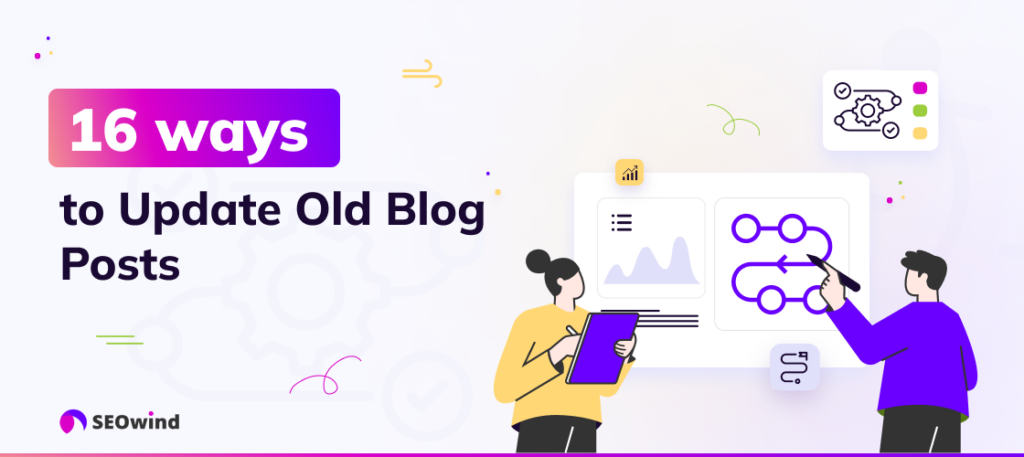
Revising your existing content allows you to breathe new life into your blog and attract more organic traffic. So, let’s discuss the essential steps for effectively updating your old blog posts.
Conduct Fresh Keyword Research
Before we do any actual updating, it’s crucial to conduct fresh keyword research. Over time, search trends and user behavior can change, so it’s essential to align your content with the most current and relevant keywords. Use tools like Google Keyword Planner, SEMrush, or Ahrefs to identify high-volume, low-competition keywords that are relevant to your blog post topic. This will help you optimize your content for better search engine visibility and attract more targeted traffic.
Rewrite Titles, Headlines, and Meta Descriptions for Clarity and SEO
Your blog post’s title, headlines, and meta description play a vital role in both SEO and user engagement. Take the time to craft compelling and descriptive titles that accurately reflect the content of your post while incorporating your target keywords. Ensure that your headlines are clear, concise, and attention-grabbing to entice readers to click through and explore your content further. Additionally, optimize your meta descriptions to provide a brief and enticing summary of your blog post, encouraging users to visit your site from the search engine results pages (SERPs).
Update Outdated Information, Statistics, and Broken Links
One of the primary reasons to update old blog posts is to ensure that the information and data presented are accurate and up-to-date. Review your content for outdated statistics, industry trends, or best practices that may have evolved since the original publication date. Replace old data with the most recent and reliable information available, and be sure to cite your sources to enhance your content’s credibility.
Additionally, check for any broken links in your blog post. Over time, external resources may change or become unavailable, leading to a poor user experience and potentially hurting your SEO. Use tools like Screaming Frog or Broken Link Checker to identify and fix any broken links, ensuring that your readers can access all the valuable resources you’ve provided.
Expand or Refine Ideas for Depth and Value
As you revisit your old blog posts, take the opportunity to expand on the topics covered or refine your ideas for greater depth and value. Look for areas where you can provide more detailed explanations, actionable tips, or real-world examples to enhance the reader’s understanding and engagement.
For instance, if your original post covered a broad topic, consider breaking it down into more specific subtopics or creating a series of related posts that dive deeper into each aspect. Expanding your content and providing more comprehensive coverage helps establish your blog as a go-to resource for your target audience.
Target search intent early
When updating your old blog posts, address the search intent of your target audience right from the start. Put yourself in your readers’ shoes and think about what they’re hoping to find when they search for the keywords you’re targeting. Are they looking for a step-by-step guide, a list of tips, or a comprehensive overview of the topic? By understanding and catering to their search intent early on in your post, you’ll produce content that keeps readers engaged and increases the likelihood that they stick around to read more.
For example, if you’re updating a post about creating a budget, immediately provide a clear, actionable guide. Don’t beat around the bush with a lengthy introduction; instead, dive right into the steps your readers need to take to achieve their goals.
Optimize Content for User Intent and Conversion Optimization
In addition to targeting search intent, it’s important to optimize your content for user intent and conversion optimization. This means providing value to your readers beyond just answering their initial query. Think about how you can guide them further along their journey, whether by offering additional resources, encouraging them to sign up for your email list, or promoting a relevant product or service.
When updating your old blog posts, look for opportunities to add CTAs that align with your readers’ goals. For instance, if you’re updating a post about the benefits of meditation, you might include a CTA inviting readers to download a free guided meditation audio file in exchange for their email address.
Enhance Readability and Format Adjustments
As you update your old blog posts, pay attention to readability and formatting. Break up long paragraphs into shorter, more digestible chunks, and use subheadings to organize your content and make it easier to scan. Consider adding bullet points or numbered lists to highlight key takeaways or steps in a process.
Additionally, make sure your font size and line spacing are easy on the eyes. A font size of 16px or larger and a line height of 1.5 or more can make a big difference in readability, especially on mobile devices.
Improve Visuals: Add or Update Images, Videos, Infographics
Finally, don’t forget the power of visuals in your updated blog posts. High-quality images, videos, and infographics can break up text, illustrate key concepts, and make your content more engaging and shareable.
When updating your old posts, look for opportunities to add or update visual elements. This might mean replacing outdated screenshots, creating new infographics to visualize data or processes, or embedding relevant videos from your YouTube channel.
Just be sure to optimize your visuals for SEO by including descriptive file names and alt text. This will help search engines understand the content of your images and improve your chances of ranking in image search results.
Change the Formatting or Layout
When you’re updating an old blog post, pay attention to formatting and layout. A well-structured post with clear headings, subheadings, and bullet points can significantly improve readability and user engagement. Break up long paragraphs into shorter, more digestible chunks of information. Use bold or italicized text to emphasize key points and make your content more visually appealing.
In addition, think about the overall layout of your post. Is it easy to navigate? Are there clear sections that guide the reader through the content? If not, consider reorganizing your post to create a more logical flow of information.
Add the Current Year to the Heading Tag
One simple but effective way to signal to both search engines and readers that your content is fresh and relevant is to add the current year to your heading tag. For example, if you’re updating a post about “The Best SEO Strategies,” consider changing the title to “The Best SEO Strategies for [Current Year].”
This small change can make a big difference in how your post is perceived. It shows that you’re actively maintaining and updating your content, which helps build trust with your audience and improve your search engine rankings.
Add an FAQ section
Another great way to update your old blog posts is by adding an FAQ section. This is particularly useful if you’ve received a lot of questions or comments on your original post. By addressing common queries and concerns directly in your post, you can provide additional value to your readers and potentially rank for long-tail keywords related to those questions.
When creating your FAQ section, use clear, concise language and structure your answers so they are easy to read and understand. You can also use schema markup to help search engines better understand the information you’ve covered.
Publish with a New Date
Finally, when you’ve finished updating your old blog post, publish it with a new date. This signals to search engines and readers that the content has been recently updated and is more likely to be relevant and accurate.
Posts with a lot of high-quality inbound links have a better shot at ranking when you do a page refresh. So, if you have an old post that’s already performing well in terms of backlinks, updating it and republishing with a new date can give it an extra boost in search engine rankings.
Upgrade Internal and External Linking Strategies
Internal links help guide readers to other relevant content on your site, keeping them engaged and increasing the time they spend with your brand. Look for opportunities to naturally link to other blog posts or pages that expand on the topics you’re discussing.
External links to high-quality, authoritative sources can also boost your post’s credibility and provide additional value to your readers. Just be sure to choose your external links wisely and avoid linking to competitors or low-quality sites.
Add a TL;DR Section
Today, many readers appreciate a quick summary of your post’s key points. Adding a “Too Long; Didn’t Read” (TL;DR) section at the beginning or end of your updated post can help readers quickly grasp the main ideas without reading the entire article.
Your TL;DR should be concise and engaging, enticing readers to dive into the full post for more details. Think of it as a highlight reel that showcases the most valuable insights and takeaways from your content.
Reindex Your Blog Post with Google
Once you’ve updated your old blog post, you’ll want Google to recrawl and reindex it as soon as possible. One way to speed up this process is to submit your updated URL to Google Search Console.
Simply navigate to the URL inspection tool, enter your post’s URL, and click “Request Indexing.” This alerts Google that you’ve made changes to the page and encourages the search engine to recrawl it sooner rather than later.
Re-promote the NEW “Old” Blog Post
Don’t let your updated blog post sit idle – give it the promotion it deserves! Share it across your social media channels, highlighting the new and improved content for your followers.
You can also consider reaching out to industry influencers or websites that previously linked to your old post, letting them know about the update and encouraging them to share or link to the new version.
Finally, don’t forget about your email list! Send out a newsletter announcing the updated post and inviting your subscribers to check out the fresh content. By actively re-promoting your updated blog post, you can drive fresh traffic and attract new readers who may have missed it the first time around.
How to Update Old Blog Posts for SEO with AI – SEOwind Tutorial

Are you looking for a way to breathe new life into your old blog posts and boost your SEO rankings? Look no further than SEOwind, the AI-powered tool that makes updating your content a breeze. In this tutorial, we’ll walk you through the simple steps to revamp your blog posts and watch your traffic soar.
Step 1: Provide Us with a Focus Keyword and Article Link
To get started, all you need to do is give SEOwind your focus keyword and a link to the article you want to update. This helps our AI understand your post’s context and main topic, allowing it to make targeted improvements that align with your SEO goals.
Step 2: Choose the Features to Upgrade
Next, select which aspects of your blog post you’d like SEOwind to enhance. Here are some of the powerful features at your fingertips:
Add Internal Links
Interlinking your content is crucial for SEO, as it helps search engines understand your site structure and distribute link equity. By integrating with Google Search Console, SEOwind automatically identifies relevant internal linking opportunities and adds them seamlessly to your post.
Add Your Custom Insights
Do you want to incorporate unique insights or expert knowledge into your post? Provide SEOwind with your custom content, and our AI will intelligently weave it into your article, placing it in the most relevant and impactful sections.
Add Stats and Quotes
Adding credible statistics and quotes can greatly enhance the authority and trustworthiness of your content. SEOwind takes the hassle out of research by finding up-to-date, relevant data and strategically inserting it into your post to support your key points.
Step 3: Enjoy the Updated Content
Once you’ve selected your desired features, sit back and let SEOwind work its magic. Here’s what happens behind the scenes:
We Do Content Research, Analyze SERPs and Their Content to Identify What’s Missing in Your Article
SEOwind conducts thorough research on your topic by studying top-ranking pages in the SERPs to pinpoint content gaps and opportunities for improvement in your post. This ensures your updated article is comprehensive, valuable, and highly competitive.
AI with Relevant Prompts Fills in Content Gaps
Armed with insights from the content research phase, SEOwind’s sophisticated AI generates highly relevant, engaging content to fill in any gaps or weaknesses in your post. The prompts are carefully crafted to maintain your brand voice and style while delivering the information your audience craves.
And there you have it! In just three simple steps, SEOwind helps you transform your old blog posts into SEO powerhouses. By leveraging the latest AI technology and best practices for content optimization, you can give your blog a major boost without the time-consuming manual effort. So, why wait? Start updating your posts with SEOwind today and watch your search engine rankings and traffic reach new heights!
Avoiding Common Mistakes When Updating Your Blog Posts
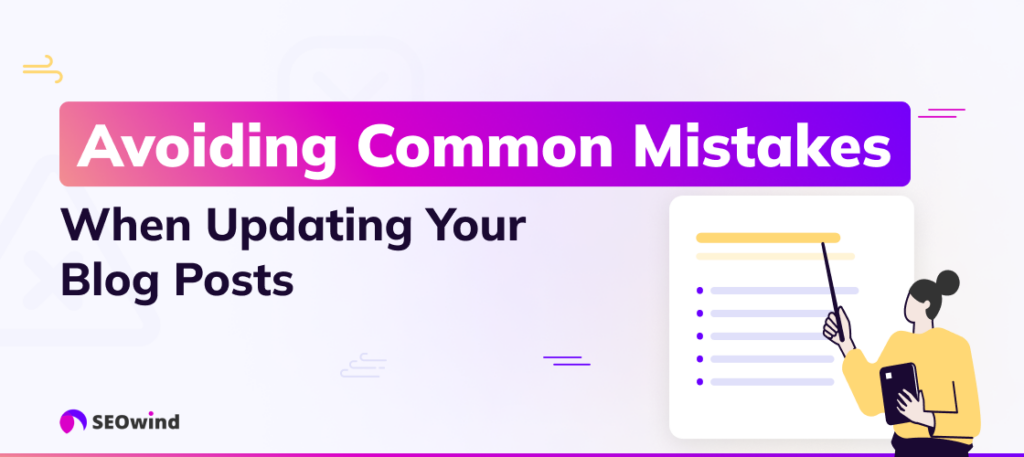
When you set out to update your old blog posts, you’ll need to steer clear of some common challenges that could undermine your efforts.
Maintain Structure and Flow
One mistake to avoid is simply adding new content without considering the overall structure and flow of the article. While expanding on ideas is valuable, make sure the additions seamlessly integrate with the existing content, maintaining a logical progression and coherence throughout the post.
Balance SEO and the User Experience
Another frequent misstep is focusing solely on keyword optimization at the expense of the user experience. Yes, conducting fresh keyword research is crucial, but don’t unnaturally stuff your updated post with keywords. Instead, prioritize the creation of valuable, engaging content that naturally incorporates relevant keywords. Remember, the goal is to provide a satisfying experience for your readers while simultaneously improving your search engine rankings.
Address Technical Aspects
It’s also important to pay attention to the technical aspects of updating your blog posts. Failing to update the publication date, neglecting to optimize images and videos, or leaving broken links unaddressed can hinder the effectiveness of your updates. Pay attention to these details to ensure your refreshed content is polished and user-friendly.
Make Substantial Improvements
Lastly, don’t fall for the trap of making superficial changes without substantially enhancing the value of your content. Simply rephrasing sentences or swapping out a few words won’t yield the desired results. Take the time to critically evaluate your post, identify areas for improvement, and make meaningful updates that elevate the quality and relevance of your content.
By sidestepping these common mistakes, you’ll be well on your way to successfully revitalizing your old blog posts and reaping the benefits of improved SEO and reader engagement. As Dandy Marketing highlights, updating old blog posts can boost their relevance, quality, and alignment with current SEO practices, leading to better visibility and rankings on search engine results pages.
Promoting Your Updated Blog Posts Effectively
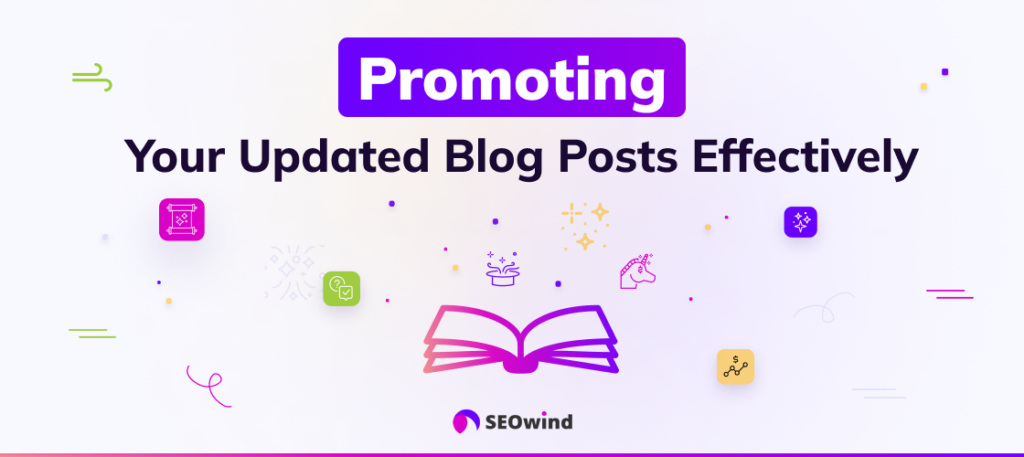
Leverage Your Email List
Once you’ve updated your old blog posts, it’s essential to promote them effectively to drive traffic and boost their visibility. One powerful strategy is to craft a compelling email highlighting the key updates and improvements you’ve made to the post and encouraging your subscribers to check it out. This brings immediate traffic and helps to re-engage your audience and keep them informed about your latest content.
Utilize Social Media
Social media is another crucial channel for promoting your updated blog posts. Share the updated post across your social media profiles, including Twitter, Facebook, LinkedIn, and Instagram. Use eye-catching visuals and engaging captions to grab attention and entice your followers to click through. Consider using relevant hashtags to expand your reach and attract new readers who are interested in your topic.
Engage in Influencer Outreach
Don’t underestimate the power of influencer outreach when promoting your updated content. Identify influencers and thought leaders in your niche who might find your updated post valuable. Reach out to them via email or social media, sharing a brief overview of the updates you’ve made and how their audience could benefit from reading it. If they find your content compelling, they may share it with their followers, exposing your blog to a broader audience.
Explore Content Syndication
Another effective way to promote your updated blog posts is through content syndication. Reach out to reputable websites or platforms in your industry and offer them the opportunity to republish your updated post. This not only expands your reach but also helps to establish your authority and credibility within your niche. Just be sure to include a canonical link to the original post on your website to avoid duplicate content issues.
Consider Paid Promotion
Lastly, consider using paid promotion to give your updated blog posts an extra boost. Platforms like Facebook Ads, Twitter Ads, and Google Ads allow you to target specific audiences based on their interests, demographics, and behaviors. By creating compelling ad copy and visuals, you can drive targeted traffic to your updated posts and attract new readers who are likely to engage with your content.
Maintain Consistent Promotion
Remember, promoting your updated blog posts is an ongoing process. Keep sharing them regularly on social media, include them in your email newsletters, and look for new opportunities to showcase them to your target audience. By consistently promoting your updated content, you’ll maximize its impact and drive long-term success for your blog.
Monitoring SEO Performance After Updates

Once you’ve updated your old blog posts, it’s crucial to monitor their SEO performance to gauge the effectiveness of your efforts. Keep a close eye on key metrics such as organic traffic, rankings, and bounce and conversion rates. Tools like Google Analytics and Search Console provide valuable insights into how your updated content is performing.
Pay attention to any changes in rankings for your target keywords. If you notice a significant improvement, it’s a good indication that your updates are resonating with both search engines and users. On the other hand, if you don’t see much movement or your ranking declines, it may be time to reevaluate your strategy and make further adjustments.
Another critical metric to monitor is user engagement. Are visitors spending more time on your updated blog posts? Are they interacting with the content, leaving comments, or sharing it on social media? Positive engagement signals can help boost your search engine rankings over time.
It’s also a good idea to set up custom alerts in Google Analytics to notify you of any significant changes in traffic or user behavior. This way, you can quickly identify and address any issues that arise.
Remember, SEO is an ongoing process, and monitoring your performance is vital to long-term success. By regularly tracking your metrics and making data-driven decisions, you can continually refine your content strategy and optimize your blog posts for both search engines and readers.
Best Practices for Periodically Reviewing and Updating Content
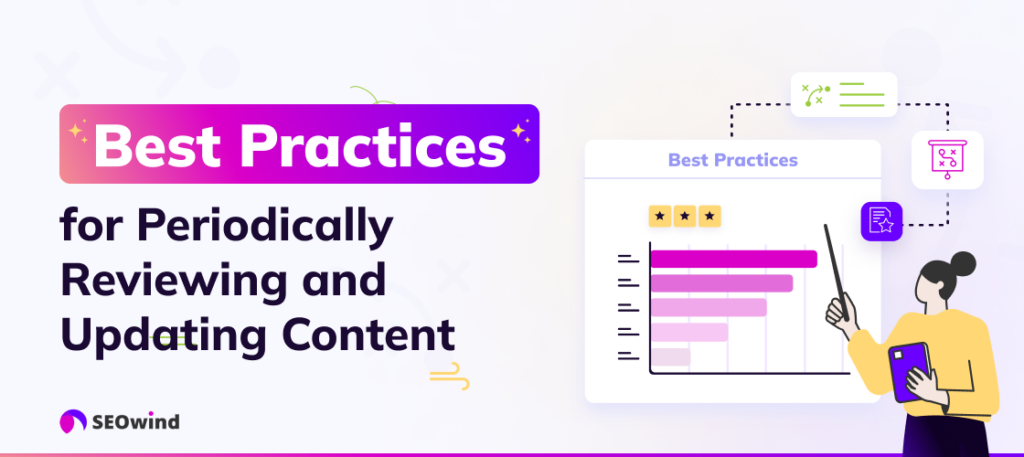
To ensure your blog posts remain relevant and continue to drive traffic, establish a regular schedule for reviewing and updating your content. Here are some best practices to keep in mind:
- Set a consistent review schedule: Depending on the nature of your content and industry, you may need to review your blog posts quarterly, bi-annually, or annually. Stick to a consistent schedule to ensure your content remains up-to-date and relevant.
- Prioritize high-performing and evergreen content: Focus on updating blog posts that consistently drive traffic, rank well, or cover evergreen topics. These posts have the most potential to benefit from regular updates and improvements.
- Monitor search engine rankings and traffic: Keep an eye on your blog posts’ search engine rankings and traffic. If you notice a decline in either, it may be time to review and update the content to maintain or improve its performance.
- Stay informed about industry trends and developments: Regularly research and stay updated on the latest trends, statistics, and best practices in your industry. This will help you identify opportunities to update your content with fresh insights and information.
- Encourage reader feedback: Engage with your audience and encourage them to provide feedback on your blog posts. Their comments and questions can help you identify areas where your content may need clarification, expansion, or updates.
- Maintain a content inventory: Keep a detailed inventory of your blog posts, including their publication dates, target keywords, and performance metrics. This will help you track which posts need attention and when they were last updated.
By following these best practices and incorporating them into your content management strategy, you’ll be well-equipped to keep your blog posts fresh, relevant, and optimized for search engines and readers alike. Remember, the key to successful content updating is consistency and a commitment to providing value to your audience.
The Role of Quality Content in SEO Beyond Updates

The Foundation of SEO Success
While updating old blog posts is a crucial aspect of SEO, the foundation of any successful SEO strategy is consistently creating high-quality content. This goes beyond merely updating existing posts; it involves crafting valuable, informative, and engaging pieces that resonate with your target audience.
Build Trust and Credibility
Quality content is the key to attracting and retaining readers, establishing your brand as an authority in your niche, and driving organic traffic to your website. You build trust and credibility when you produce content that helps your audience solve their problems or answers their questions. This trust translates into increased engagement, longer dwell times, and lower bounce rates, each of which positively impacts your SEO rankings.
The Power of Backlinks
High-quality content is more likely to earn natural backlinks from other reputable websites. Backlinks are a critical ranking factor in Google’s algorithm, as they signal that other websites find your content valuable and relevant enough to link to it. The more high-quality backlinks you acquire, the higher your chances of ranking well in SERPs.
Take care of the User Experience
In addition to its direct impact on SEO, quality content also plays a vital role in user experience (UX). When visitors land on your website and find well-written, informative, and visually appealing content, they are more likely to explore further, engage with your brand, and potentially convert into customers. On the other hand, if your content is thin, poorly written, or fails to address user needs, visitors will quickly bounce off your site, negatively affecting your SEO and overall online success.
Key Strategies for Creating Quality Content
To create quality content that drives SEO success, focus on:
- Understanding your target audience and their needs
- Conducting thorough keyword research to identify relevant topics
- Crafting compelling headlines and meta descriptions
- Writing in-depth, well-structured, and easy-to-read content
- Incorporating visuals, such as images, videos, and infographics
- Optimizing content for both users and search engines
- Promoting your content through social media and email marketing
By prioritizing quality content creation alongside regular updates to existing blog posts, you can establish a strong foundation for long-term SEO success. While updates are important, the true power of SEO lies in consistently delivering valuable, high-quality content that meets the needs of your target audience.
Leverage AI for Quality Content Creation
At SEOwind, we understand the importance of quality content in driving SEO success. Our AI-powered platform helps you create comprehensive, high-quality articles and blog posts based on extensive SEO and content research. By leveraging the power of AI and human expertise through our CyborgMethod™, SEOwind enables you to scale up your content creation process while maintaining the quality and authenticity that resonates with your audience. With our tool, you can produce content that ranks well in search engines and converts your readers into loyal customers.
FAQ
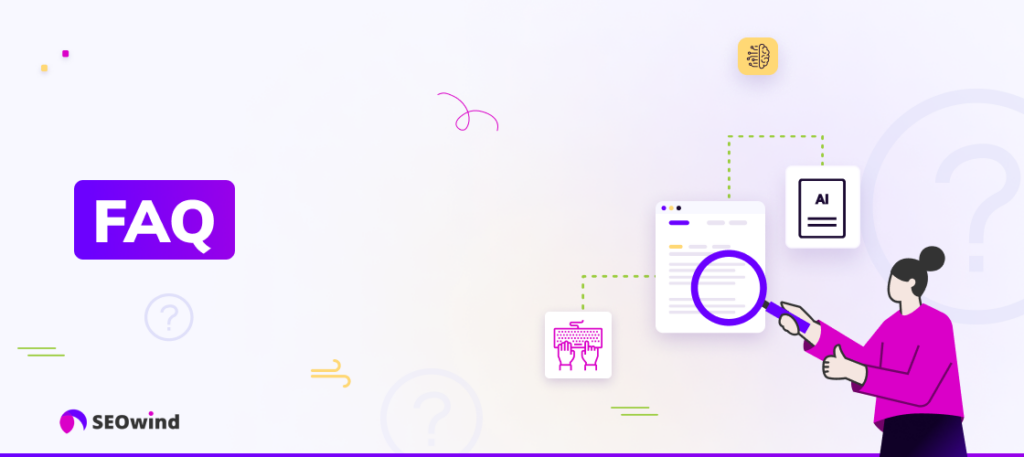
Is updating old blog posts worth it?
Absolutely! Updating old blog posts can be incredibly beneficial for your SEO and overall content strategies. By refreshing outdated information, optimizing for current search trends, and improving the overall quality of your content, you breathe new life into your existing blog posts and attract more organic traffic.
Updating old blog posts allows you to capitalize on the authority and backlinks that those posts have already earned over time. Instead of starting from scratch with a new post, you can leverage the existing SEO value of old content and boost its performance with strategic updates.
On top of that, regularly updating your old blog posts demonstrates to search engines that your website is active and provides fresh, relevant content. This positively impacts your search rankings and helps you maintain a strong online presence in your niche.
How often should you update old blogs?
The frequency of updating old blog posts depends on various factors, such as the nature of your industry, the pace of change in your niche, and the volume of content on your website. However, as a general guideline, I recommend reviewing and updating your old blog posts at least once a year.
Some blog posts may require more frequent updates, especially if they cover rapidly evolving topics or contain time-sensitive information. For example, if you have a blog post about industry statistics or trends, you may need to update it every few months to ensure the data remains accurate and relevant.
On the other hand, evergreen content that covers timeless topics may not require updates as frequently. Nevertheless, reviewing these posts periodically ensures they align with your current brand voice, are optimized for any new relevant keywords, and make any necessary improvements to the content’s structure or formatting (No idea what this is supposed to mean in the context of this sentence).
What are the risks of not updating old blog posts for SEO?
While not updating old blog posts won’t necessarily harm your SEO, it can lead to missed opportunities for improving your search rankings and driving more organic traffic to your website. By neglecting to update your old content, you risk the following:
- Outdated information: If your old blog posts contain outdated or inaccurate information, it can negatively impact your credibility and user experience. Visitors may lose trust in your brand if they come across content that is no longer relevant or correct.
- Missed keyword opportunities: Search trends and user preferences evolve over time. By not updating your old blog posts, you may miss out on targeting new, relevant keywords that could drive more targeted traffic to your website.
- Decreased engagement: Old blog posts that lack current information, engaging visuals, or optimized formatting may fail to capture and retain your audience’s attention. This can lead to higher bounce rates and lower engagement metrics, which indirectly affect your SEO performance.
- Stagnant search rankings: If your competitors actively update their content and optimize for current search trends, they may outrank you for important keywords. By not updating your old blog posts, you risk losing ground in SERPs and missing out on valuable organic traffic.


